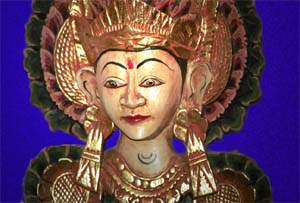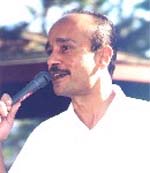
|
September 11, 2001: a crack in consciousness, a violent rupture of reality. As those planes rammed into the Twin Towers, a boundary of devastation crossed and the end of an era of 'model minority' innocence for Brown people (from West and South Asia primarily) in the U.S. and, to a lesser degree, all over the Western world. Palestinian feminist and activist Suheir Hammad, author of Born Palestinian, Born Black, writes:
there have been no words, --Suheir Hammad: 'Thoughts' in Voices of Sanity: Reaching Out for Peace, New Delhi: Lokayan Publishers, 2001.)
The fallout from Sept. 11 made racism respectable and provided a martyred 'they did this to us' rationalization of this racist bedrock. Suheir Hammad talks about Oklahoma City and Tim McVeigh: we did not vilify all white men when mcveigh bombed oklahoma. america did not give out his family's addresses or where he went to church, or blame the bible or pat robertson. and when the networks air footage of palestinians dancing in the street, there is no mention that these images are over a decade old. (Voices, p.11). McVeigh was treated as the monster, the aberrant one, the 'black' sheep etc. As such, whites as a category did not have to bear his cross. Instead, of course most of us are decent, patriotic normal Americans became the unconscious implicit mantra that sustained the 'normalizing' and norm-setting white privilege.
Little Muslim girls, four and five years old were brutally raped. One of the most compelling images of the carnage was the photograph of an unknown Muslim, hands folded, face a mask of abjected terror, begging for his life. No one knows who he was or whether he made it alive. The starkness of the photograph that has been splashed all over the local media, is a mute symbol of the sheer destructiveness of religious chauvinism and hate, fueled by a fundamentalist ideology. That the massacre of the Muslim innocents was triggered by the murder of Hindus traveling by train in Godhra, Gujarat is not an excuse or a rationale, though it's been used as both by defensive Hindu partisans and by the Hindu fundamentalist BJP state government. Had the Godhra perpetrators been found and tried and convicted to the full extent allowed by the laws and the Indian Constitution, that would have been a different matter. Echoing the old Gandhian principle, a world in which 'eye for eye, tooth for tooth' is followed is a world with a helluva lot of blind, toothless people. Behind the rash of sectarian terror lies the peculiar phenomenon of Hindu fundamentalism, peculiar in that with all its oppression of women and lower castes through the ages, Hinduism has prided itself on an 'all paths lead to the Divine' kind of pluralism and respect for diversity. The 'me too-ism' as UN diplomat and writer Shashi Tharoor calls it, whereby many primarily upper caste Hindus saw this pluralism as a sign of weakness (tying into castration and manhood issues for some), is a relatively new face of Hinduism. After all, the new chilling 'Hindutva' rhetoric claims, if Muslims and Christians can be violent, vengeful and ethnocentric, so can and should we, when our interests are threatened.
 Aside from the oddity of the 'fundamental' raising its ugly head in Hinduism, the features of Hindu fundamentalism have 'family resemblances' (as Wittgenstein would say), with the language games of Christian, Islamic and other brands of fundamentalism. It shares with them a simplistic retro nostalgia for an idyllic past, an aversion to modernization, a cheap substitution of the most oppressive patriarchal family values for a genuine ethics of compassion, selective textual and other literalism and a bigoted binary us/them politics of hate toward other religious communities/other interpretations of Hinduism.
Aside from the oddity of the 'fundamental' raising its ugly head in Hinduism, the features of Hindu fundamentalism have 'family resemblances' (as Wittgenstein would say), with the language games of Christian, Islamic and other brands of fundamentalism. It shares with them a simplistic retro nostalgia for an idyllic past, an aversion to modernization, a cheap substitution of the most oppressive patriarchal family values for a genuine ethics of compassion, selective textual and other literalism and a bigoted binary us/them politics of hate toward other religious communities/other interpretations of Hinduism.
Given this context, I showed up at a conference on communalism and religious sectarianism organized by Vigil India, a secular, interfaith movement in India, one that challenges the majoritarian hate politics unleashed by the BJP and its political cronies. One valuable lesson of the conference was the emphasis on fighting sectarianism with a 'left' leaning spirituality. Some speakers echoed Ruth Vanita's sentiments in her paper 'Whatever Happened to the Hindu Left?' where Vanita argues that the Hindu of the past two centuries often (sometimes for the 'wrong' colonial reasons) tended to deny her/his Hinduism, leaving it to extreme right wing formulations of Hinduism to rush in to fill the identity void. Many stressed the need to come up with alternative positive 'rooted' mythologies and interpretations to combat fundamentalism and sectarianism in all faiths. I rejoiced in these views. For a long time, that's been one of my many strategies to defeat fundamentalist rhetoric in the US--to twist the fundamentalist reality handle vigorously by stressing the higher aspects of Christianity and other faiths and by finding non-bigoted, compassion-based texts and myths in the major faiths of the world. One royal mess-up of secular discourse including post-modern, post-Nietzschean conversations is that they tend to be agnostic/atheistic or to ignore religion as a dead 'has been.' Great mistake and one that easily fuels the extremist backlash.
From August 2002 through February 2003: I attended many personal growth and healing workshops at the School of Ancient Wisdom. This school is a beautifully landscaped nine acre facility replete with English cottages, fountains and a giant sculpture of Prometheus the cosmic fire stealer in Greek mythology, the ally of rebellious humanity wresting fire from the gods. Here, faraway from the bellicose strutting and the fundamentalist, world-conquering crusade of the Bush machine and the genocidal religious nuts in India and elsewhere, here in Devanahalli (literally, the abode of the gods), about 20 miles from Bangalore, it was possible to find a sense of calm in the midst of all these raging world tempests. The school was founded by Manizeh, a Parsee woman steeped in Theosophy (which, with the Golden Dawn, is one of the seldom acknowledged ancestors of the American New Age movement. The Theosophists have deep roots in India since the early 20th Century). The school is open to all modes of spiritual seeking in all religious traditions. One meditation technique among the myriad that I learned and practised here: a profound Tantric meditation on death. You relax yourself so deeply that you can comfortably visualize yourself dying within the next 12 hours. Whom would you call? What debts, financial and emotional, would you pay off? What would you do if you knew, truly knew that you had but 12 hours of life left? Dance all night? Meditate or pray? Go on a 12 hour drinking binge and then die? Not so weirdly for those who know me well, I found myself (in meditation) spending the first 2 hours at the Strand Bookstore in Bangalore, picking up a copy of Eknath Easwaran's wonderful translation of the Katha Upanishad called 'Dialogue with Death.' In this great reflection on death, Yama the Hindu god of death initiates a young, questioning adolescent named Nachiketa.
As dawn approached, I woke up from an uneasy snoring nap, feeling feverish, nauseous and headachey. Death was approaching, swift, inexorable. To assuage a dizzying fear, I called every friend I could think of and a few enemies to tell them I was dying and all relationship screw-ups notwithstanding, I loved them. Very soon, I had a half hour left. I opened the Tibetan Book of the Dead, that great-hearted guide for safe passage across the toughest Bardo of them all. "O noble child, that which mortals call death is upon you. Fear not." Still in meditation, the facilitator Swami Nityananda (the latest guru on the Bangalore horizon) asked us to visualize life slowly leaving every limb, every cell, every pore of the body, slowly and comfortably. I froze in slow motion beginning with the toes of both feet. Finally, the death rattle, feeling the last vestiges of precarious life exiting the body through the third eye, through the Ajna Chakra, the psychic command center of the body-mind, located between the eyebrows. Then I died. The weirdest thing about this last process was that I was very comfortable and the sliver of consciousness called 'I' or 'Raj' was still there, growing flame-like. In fact, it was lucid, free and sans the usual mental clutter and chatter. This flame-like consciousness, Osiris risen, wanted to shake my grieving parents and aunts on the landing of the staircase and say to them," Look at me! Whatever happened to that thing, that object stretched out in frigid repose on that bed is not me!" This 'I' was simply the silent, impish witness to the maggoty decay of the body, the shaking sobs of those who had loved that animated body. After a long while, the teacher brought us back, the wandering astral form, the joyful bodiless consciousness slowly, almost reluctantly, re-inserted into the body. I woke up from death feeling grateful for this limited vehicle of the body, with all its aches, failures, oozes and snoozes. Incredibly, I was grateful that I had a cold and could sneeze! These meditative experiments and re-centerings have not taken away from my passionate sense of justice, from my urge to serve and change the conditions of the oppressed Other, from my 'teaching activism.' In fact, these experiments have enhanced my pro-underdog passion, given it depth, resonance and realness, perhaps just because I am no longer filled with personally venting, shrill-pitched rage and self-pity. At least, not all the time. Osho has said that his vision for the new human being of a new millennium is "Zorba the Buddha"--one who fuses the dancing, drinking, sexually insatiable, celebratory Zorba (the hero of Nikos Kazantzakis' Zorba the Greek) with the meditative calm of the Buddha. To which I'd like to add an ingredient: the radical passion of a Karl Marx, a Sojourner Truth, a Gandhi. If the ideal millennial human being is this triadic synthesis, perhaps we have the seed of a new world. In fact, such a synthesis as an ideal limit toward which we stretch and reach, might act as a healthy check to the very different narcissisms of celebrator, meditator and activist. Celebrators might be rescuable from a blind, self-absorbed and often addictive hedonism, meditators from a plastic 'feel good' self-centeredness and activists from touchy separatisms and a rage that turns too easily to impotent despair. |
|
 Raj Ayyar
Raj Ayyar  Bangalore, India
Bangalore, India  Bangalore, India
Bangalore, India  Raj Ayyar
Raj Ayyar